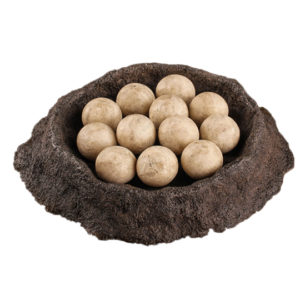Dinosaur Eggs for Easter
Dinosaurs seem to have had a very different reproductive strategy to that of mammals. In modern mammals, with size ranges comparable to those of dinosaurs, a few well-developed offspring are born at a time and they are usually quite well cared for by the parents. From evidence preserved in the fossil record, dinosaurs seem to have laid many eggs at a time and despite varying degrees of parental care, very few of the offspring survived into adulthood. Effectively, dinosaurs seem to have relied on a strategy of “quantity not quality” a strategy akin to modern reptiles such as crocodiles. Some extant species of reptile are viviparous (able to produce live young). Most scientists believe that all the known species of dinosaur were egg laying, although some palaeontologists have remarked on the wide hips of therizinosaurs and pachycephalosaurs. Were these wide hip girdles purely for making room for a large gut, or did these herbivores give birth to live young?
Dinosaur Eggs
A number or extinct reptiles are known to have given birth to live young, the remarkable Ichthyosaur fossils of Germany, where a female ichthyosaur seems to have perished and been preserved whilst in the process of giving birth. It would make sense for these superbly adapted marine reptiles to evolve a viviparous reproduction strategy. Although these animals evolved from land dwelling ancestors, they were so completely adapted to a marine existence that they physically could not clamber ashore to lay eggs, in the same way that turtles do for instance.
Dinosaur nesting strategies seem to have varied, some fossilised nests contain as few as ten eggs, whilst overs contain the remains of over 50. Some dinosaurs such as the large sauropods seem to have created a simple scrap in the ground, laid their clutch of eggs, buried them and left the developing young to their fate. Other dinosaurs such as the North American Maiasaura, seems to have nested in colonies and built more elaborate nests, consisting of a raised mound covered in vegetation, perhaps some form of incubation.
A Model of a Sauropod Nest
Dinosaur Eggs were not Large
A common misconception about dinosaur eggs is that they were very large. This is not the case. The largest dinosaur eggs were about the size of a regulation football, it is believed eggs of this size were probably laid by a sauropod (long-necked dinosaur). The shelled egg is limited in size (amniotic egg); the egg shell has to be thick enough to support the fluid contained therein, but weak enough to permit the hatching animal to break out. The thickest dinosaur egg shell exceeds 6 mm in thickness, any thicker than this and the offspring would not be able to break out of its egg.
Looking for some dinosaur themed activities for the holidays? Take a look at the wide range of dinosaur and prehistoric animal toys and gifts available from Everything Dinosaur’s award-winning website: Visit Everything Dinosaur.







Leave A Comment